Yin R. Metallurgical Process Engineering
Подождите немного. Документ загружается.

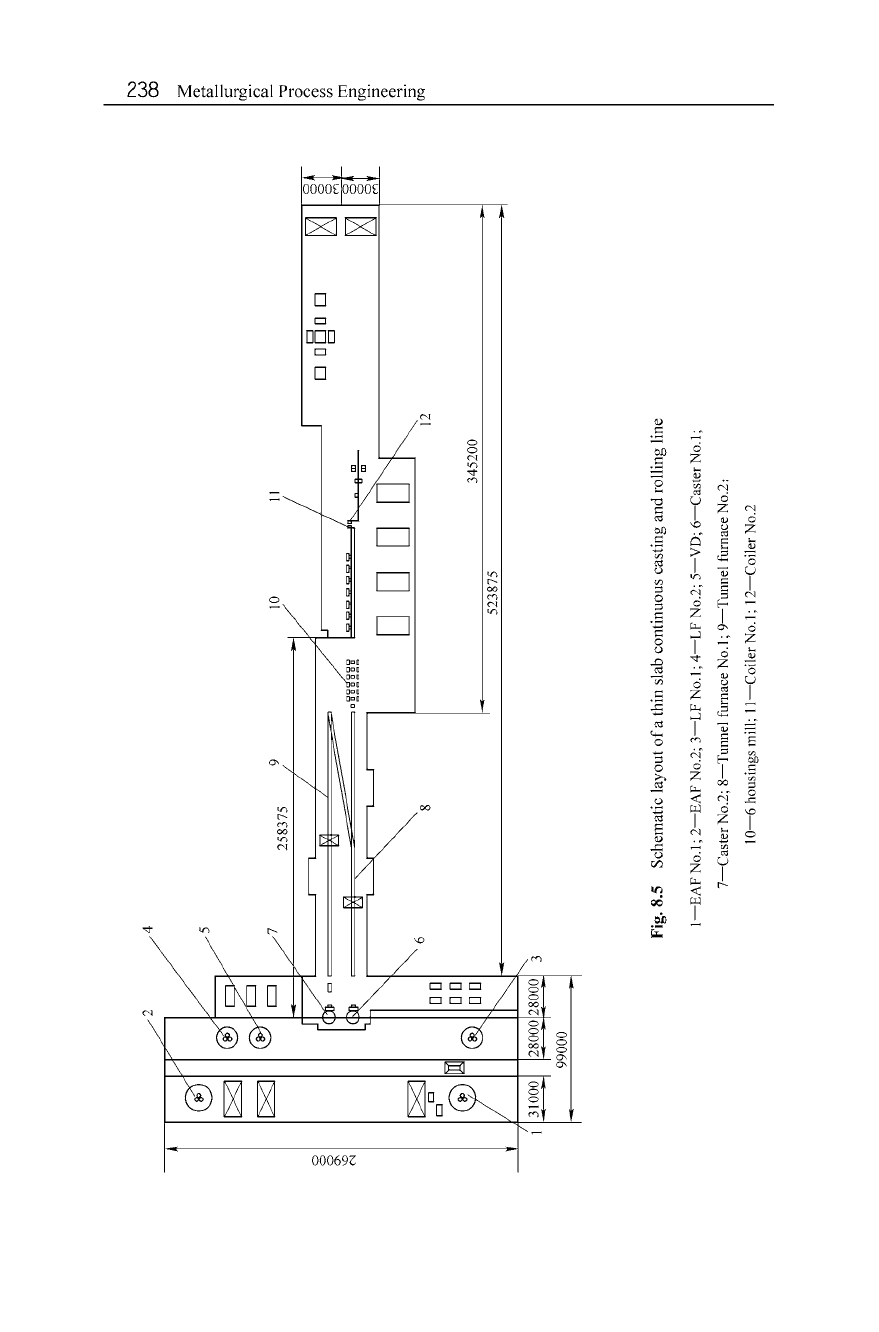
2 4
N
W
(X)
523875
345200
tIl
:l
(JQ
5'
(1)
(1)
...
5'
(JQ
$:
(1)
[
;::
cia
o'
e:.
"'0
a
()
(1)
'"
'"
o
o
o
o
M
<5
o
o
o
M
~
~
o
00000
o
12
II
10
DDDD
5
~
~
Dlfi'~g~~lfi'
"""
~~~~~~
i i
r--I
r-l
95
o
o
o
o.
~
N
99000
Fig
.8
.5 Schematic layout
of
a thin slab continuous casting and rolling line
I- EAF No. 1; 2
-EAF
No.2; 3- LF No.1; 4
-L
F No.2; 5- YD; 6
-Cas
ter No.1;
7
-Cas
ter No.2; 8- Tunnel furnace No.1; 9- Tunnel furnace No.2;
10- 6 housings mill; II - Coiler No.1; 12- Coiler No.2
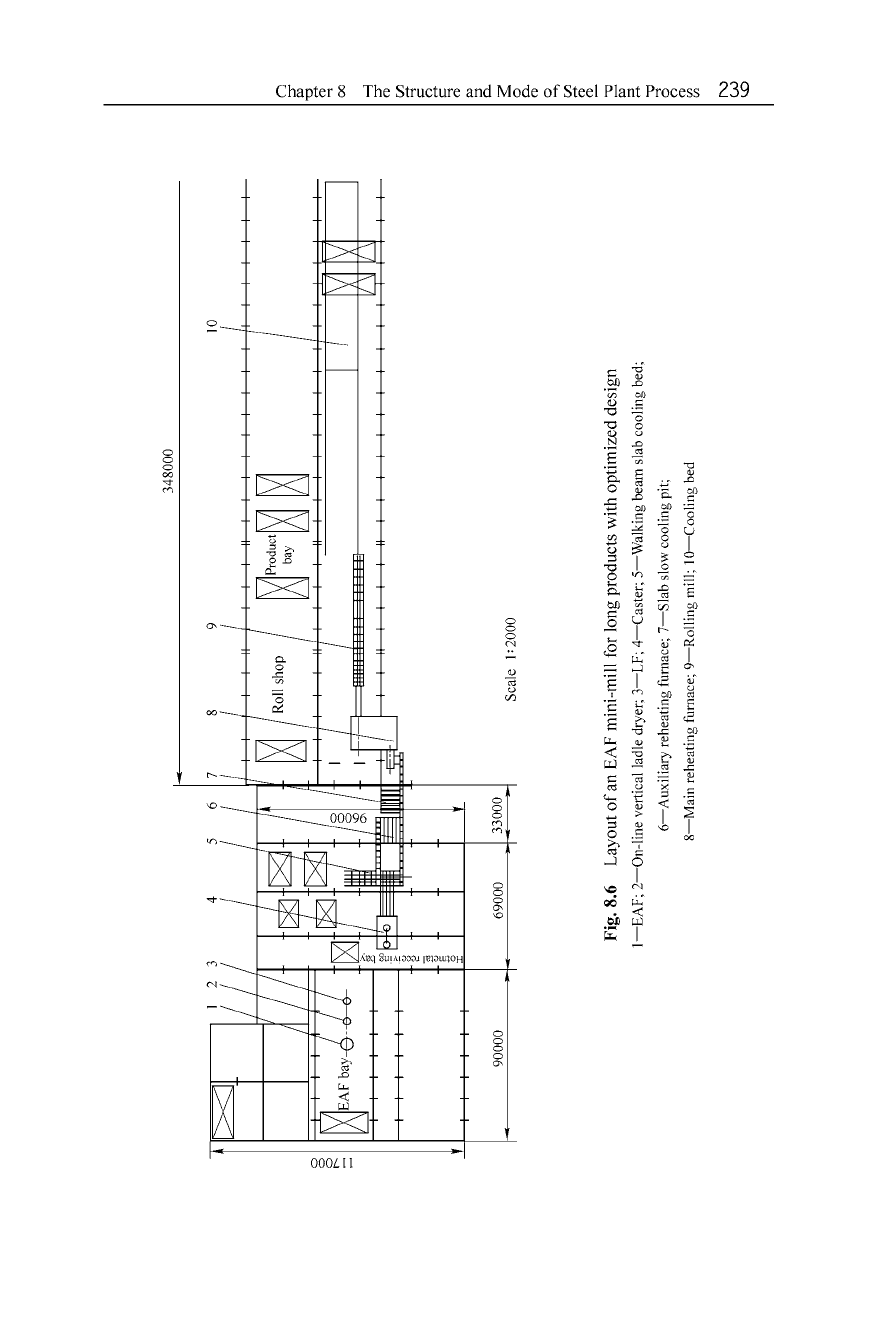
348000
Fig.8.6 Layout
of
an EAF mini-mill for long products with optimized design
]- EAF; 2- 0 n-line vertical ladle dryer; 3- LF; 4- Caster; 5- Walking beam slab cooling bed;
6
-Au
xiliary reheating furnace; 7
-S
lab slow cooling pit;
8- Main reheating furnace; 9
-R
olling mill; ]O- Cooling bed
o
o
o
r---
90000
1
:I:
69000
33000
Scale I:2000
~ProdU
C
I~
~
l6J
bay
l6J l6J
10
n
:r
:>J
-g
'"
..,
00
...,
:r
'"
:4'
..,
c
()
2
~
:>J
::::l
0-
3:::
o
0-
'"
o
.....
:4'
'"
~
"'0
~
~
"'0
d
r:
'"
'"
'"
N
W
\.0
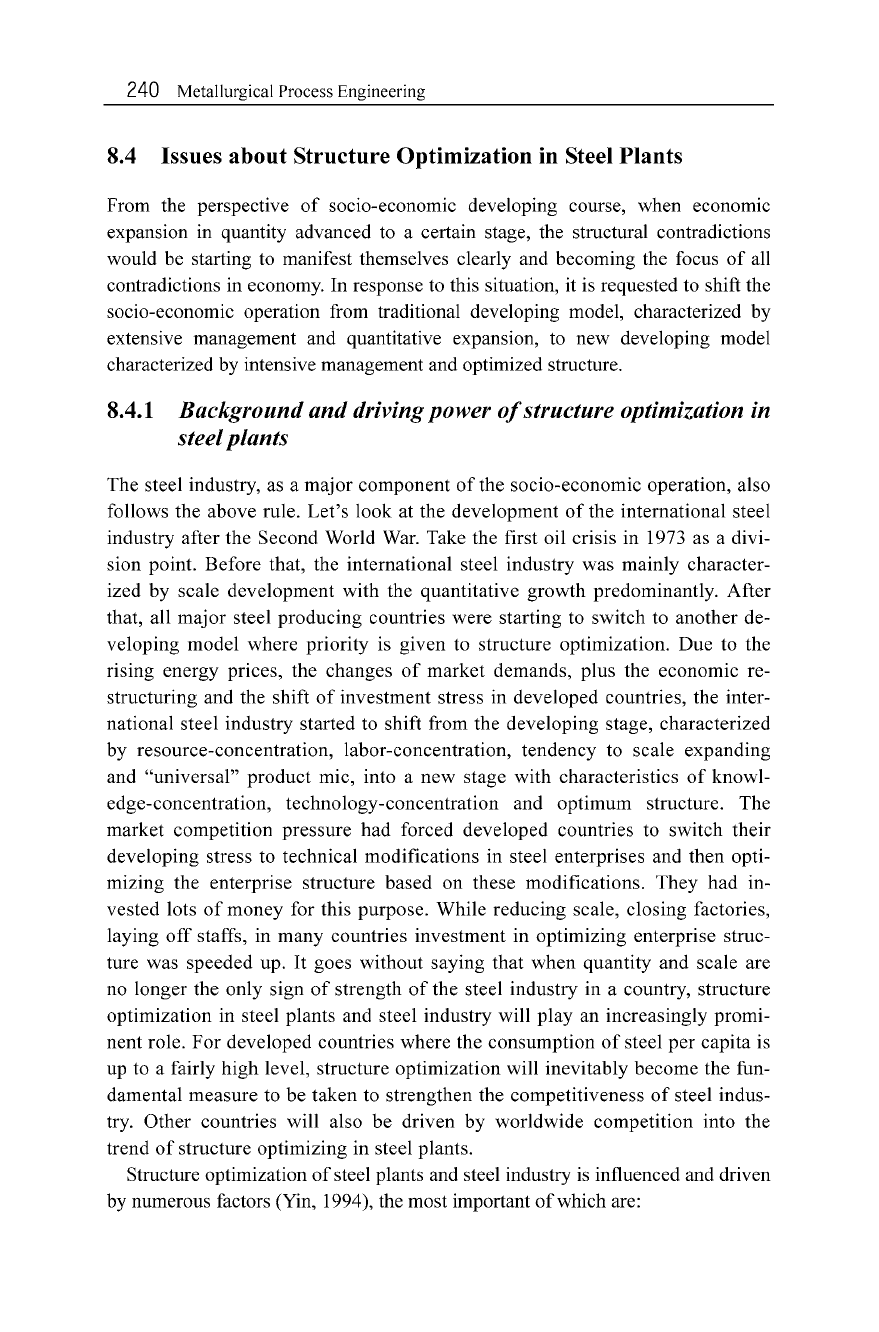
240 Metallurgical Process Engineering
8.4 Issues about Structure Optimization in Steel Plants
From the perspective
of
socio-economic developing course, when economic
expansion in quantity advanced to a certain stage, the structural contradictions
would be starting to manifest themselves clearly and becoming the focus
of
all
contradictions in economy. In response to this situation, it is requested to shift the
socio-economic operation from traditional developing model, characterized by
extensive management and quantitative expansion, to new developing model
characterized by intensive management and optimized structure.
8.4.1 Background and driving power
of
structure optimization in
steelplants
The steel industry, as a major component
of
the socio-economic operation, also
follows the above rule. Let's look at the development
of
the international steel
industry after the Second World War. Take the first oil crisis in 1973 as a divi-
sion point. Before that, the international steel industry was mainly character-
ized by scale development with the quantitative growth predominantly. After
that, all major steel producing countries were starting to switch to another de-
veloping model where priority is given to structure optimization. Due to the
rising energy prices, the changes
of
market demands, plus the economic re-
structuring and the shift
of
investment stress in developed countries, the inter-
national steel industry started to shift from the developing stage, characterized
by resource-concentration, labor-concentration, tendency to scale expanding
and "universal" product mic, into a new stage with characteristics
of
knowl-
edge-concentration, technology-concentration and optimum structure. The
market competition pressure had forced developed countries to switch their
developing stress to technical modifications in steel enterprises and then opti-
mizing the enterprise structure based on these modifications. They had in-
vested lots
of
money for this purpose. While reducing scale, closing factories,
laying
off
staffs, in many countries investment in optimizing enterprise struc-
ture was speeded up.
It
goes without saying that when quantity and scale are
no longer the only sign
of
strength
of
the steel industry in a country, structure
optimization in steel plants and steel industry will play an increasingly promi-
nent role. For developed countries where the consumption
of
steel per capita is
up to a fairly high level, structure optimization will inevitably become the fun-
damental measure to be taken to strengthen the competitiveness
of
steel indus-
try. Other countries will also be driven by worldwide competition into the
trend
of
structure optimizing in steel plants .
Structure optimization
of
steel plants and steel industry is influenced and driven
by numerous factors (Yin, 1994), the most important
of
which are:
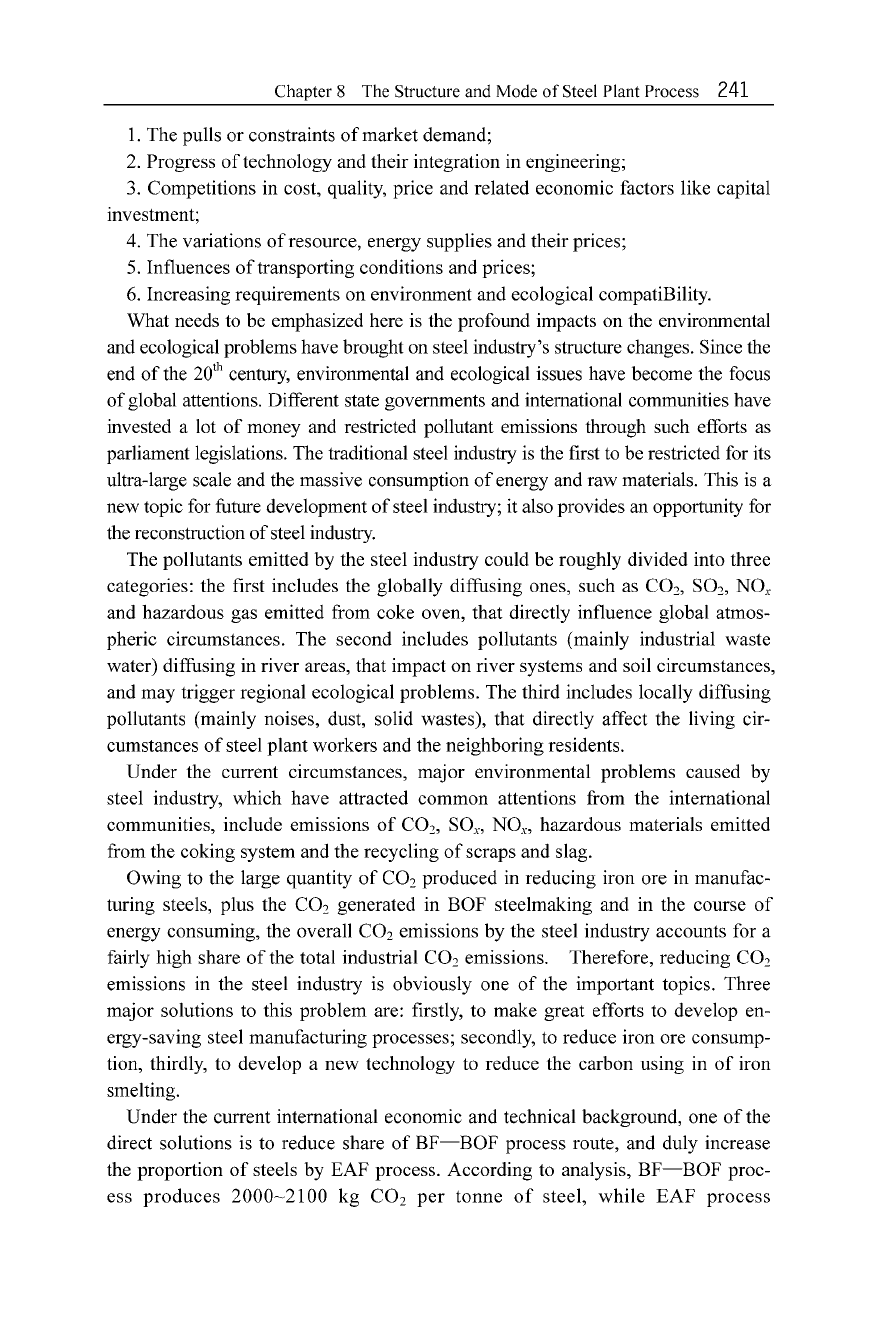
Chapter 8 The Structure and Mode
of
Steel Plant Process
241
I. The pulIs or constraints
of
market demand;
2. Progress
of
technology and their integration in engineering;
3. Competitions in cost, quality, price and related economic factors like capital
investment;
4. The variations
of
resource, energy supplies and their prices;
5. Influences
of
transporting conditions and prices;
6. Increasing requirements on environment and ecological compatiBility.
What needs to be emphasized here is the profound impacts on the environmental
and ecological problems have brought on steel industry's structure changes. Since the
end
of
the
zo"
century, environmental and ecological issues have become the focus
of global attentions. Different state governments and international communities have
invested a lot
of
money and restricted pollutant emissions through such efforts as
parliament legislations. The traditional steel industry is the first to be restricted for its
ultra-large scale and the massive consumption
of
energy and raw materials. This is a
new topic for future development
of
steel industry; it also provides an opportunity for
the reconstructionof steel industry.
The pollutants emitted by the steel industry could be roughly divided into three
categories: the first includes the globally diffusing ones, such as CO
2,
S02, NO
x
and hazardous gas emitted from coke oven, that directly influence global atmos-
pheric circumstances. The second includes pollutants (mainly industrial waste
water) diffusing in river areas, that impact on river systems and soil circumstances,
and may trigger regional ecological problems. The third includes locally diffusing
polIutants (mainly noises, dust, solid wastes), that directly affect the living cir-
cumstances
of
steel plant workers and the neighboring residents.
Under the current circumstances, major environmental problems caused by
steel industry, which have attracted common attentions from the international
communities, include emissions
of
CO
2,
sa
x,
NO
x
,
hazardous materials emitted
from the coking system and the recycling
of
scraps and slag.
Owing to the large quantity
of
CO
2
produced in reducing iron ore in manufac-
turing steels, plus the CO
2
generated in BOF steelmaking and in the course
of
energy consuming, the overall CO
2
emissions by the steel industry accounts for a
fairly high share
of
the total industrial CO
2
emissions. Therefore, reducing CO
2
emissions in the steel industry is obviously one
of
the important topics. Three
major solutions to this problem are: firstly, to make great efforts to develop en-
ergy-saving steel manufacturing processes; secondly, to reduce iron ore consump-
tion, thirdly, to develop a new technology to reduce the carbon using in
of
iron
smelting.
Under the current international economic and technical background, one
of
the
direct solutions is to reduce share
of
BF-BOF
process route, and duly increase
the proportion
of
steels by EAF process. According to analysis, BF
-BOF
proc-
ess produces
2000
~2100
kg CO
2
per tonne
of
steel, while
EAF
process

242
Metallurgical Process Engineering
produces only 800 kg (Umezawak, 1992). This will undoubtedly have a deep im-
pact on current and future structure
of
steel industry.
Coke is an indispensable fuel and reductant for traditional BF
-BOF
process.
Therefore, emissions from the coke system have become a critical constraint for
BF-BOF
process development. In addition, the increasing shortage
of
qualified
coking coal resources, will also constrain, to some extent, the survival and
development
of
BF. Non-coke ironmaking processes will enjoy greater
development in the future.
The issues
of
how to make full use
of
scrap and how to solve the problem
of
scrap piles occupying too much land and environmental problem have become
important economic - environmental topics.
It is believed that steelmaking proc-
ess capable
of
making full use
of
recovered scraps would be supported.
In a word, environmental problems, which are drawing more and more con-
cerns from the society, will lead to profound changes in the structures
of
steel
industry.
8.4.2 Connotations
of
steel plant structure and the trend
of
steel
plant restructuring
Structure refers to the ways
of
organic connection and interactions among numer-
ous elements in system under certain circumstances conditions, also to the organi-
zation form. Structure connotation includes not only the simple quantitative ac-
cumulation and quantitative proportion among various elements, more impor-
tantly, but also their quality advancedness, organization rationality and dynamic
adjustability, as well as their inherent vitalities.
Steel plant structure refers to the ways
of
intrinsic connection and interactions
among various elements in a steel plant. These ways are relatively stable and con-
form with such rules as socio-economic, technological progressing, enterprise or-
ganizational and market competition rules. Fundamental elements for forming steel
plant structure include market, capital, energy and resources, transporting conditions,
quality
of
human resources and environment status. Steel plant structure and its
various elements are inter-connected and interacted.
It
plays a decisive role in a
steel plant's overall function and performance.
It can combine these elements in an
effective way, thus forming comprehensive advantages
of
the whole plant. Steel
plant structure, once formed, will have comparative stability and independence.
Therefore, what determines the competitiveness
of
a steel plant, as the main body
of
market competition, is its own product mix, process flow sheet structure, equipment
levels and capabilities, rational economic scale, and the group quality and organiza-
tional structure
of
its staffs. Meanwhile, the market competition among steel plants
will considerably facilitate the structural changes in steel industry. Therefore, the
structure optimization
of
steel industry is based on the structure optimization
of

Chapter 8 The Structure and Mode
of
Steel Plant Process
243
steel plants. Today,the objectives
of
a new round structure optimization in the inter-
national steel industry are the structural equilibrium based on original renovation to
make full use
of
the functions
of
steel manufacturing process and to play rational
role in the circular economy, and the integrated optimization targeted at a series
of
advanced techno-economic indexes. Looking at the development trends
of
inter-
national steel industry since the 1980s, we can see that, under different circum-
stances, sometimes the structure optimization in some steel plants is accompanied
by sharp increases in scale and quantity, for instance, some steel plant shifted
from mainly producing long products to producing flat products. But some enter-
prises reduced their numerous and jumbled, ultra-large scale to an appropriate
competitive one in the course
of
structure optimization. For example, some large
integrated steel plants started specializing in producing flat products, abandoning
long products production or moving the long production plant out to other place
as an entity with independent management. Some steel plants attach great impor-
tance not only to low-cost, high quality, high-efficiency, but also to energy con-
version function as power generation, to recycling and processing bulk wastes as
scrap and worthless plastics.
8.4.3 Engineering analysis
of
steelplant structural optimization
Steel plant structural optimization is conspicuously inflected in product structure,
which is closely associated with market demand, and rational economic scale. Steel
plants have always valued the importance
of
rational economic scale, which means
an economic scale with rational structure.
It
is hard to judge whether or not a steel
plant's scale is economic and rational by merely looking at its quantity. One
of
the
decisiveassessingfactorsis whether the structureis optimizedor not.
Shown in Fig. 8.7 (Yin, 1993) is the logic conception
of
steel structure optimi-
zation. The figure shows the connotations
of
steel enterprise structure. The first
thing to do in optimizing steel enterprise structure is to select products series that
fit the market demand and then select the optimized process, equipment level and
capabilities, starting from the requirements to manufacture these products. What
should be pointed out is the selections
of
process and equipment, not only de-
pending on the selection
of
products, but also are influenced by other factors,
such as resources, energy, transportation, environment, human resource quality
and capitals. Therefore, the optimization
of
steel plant structure is in fact an opti-
mization with constraints. The rational economic scale
of
steel production (prod-
ucts) is not determined arbitrarily. Apart from outside conditions like market de-
mand, it mainly depends on the level and capabilities
of
the process and equip-
ment to produce these products.
Of
course, under certain constraints, this rational
scale can fluctuate moderately within certain range.
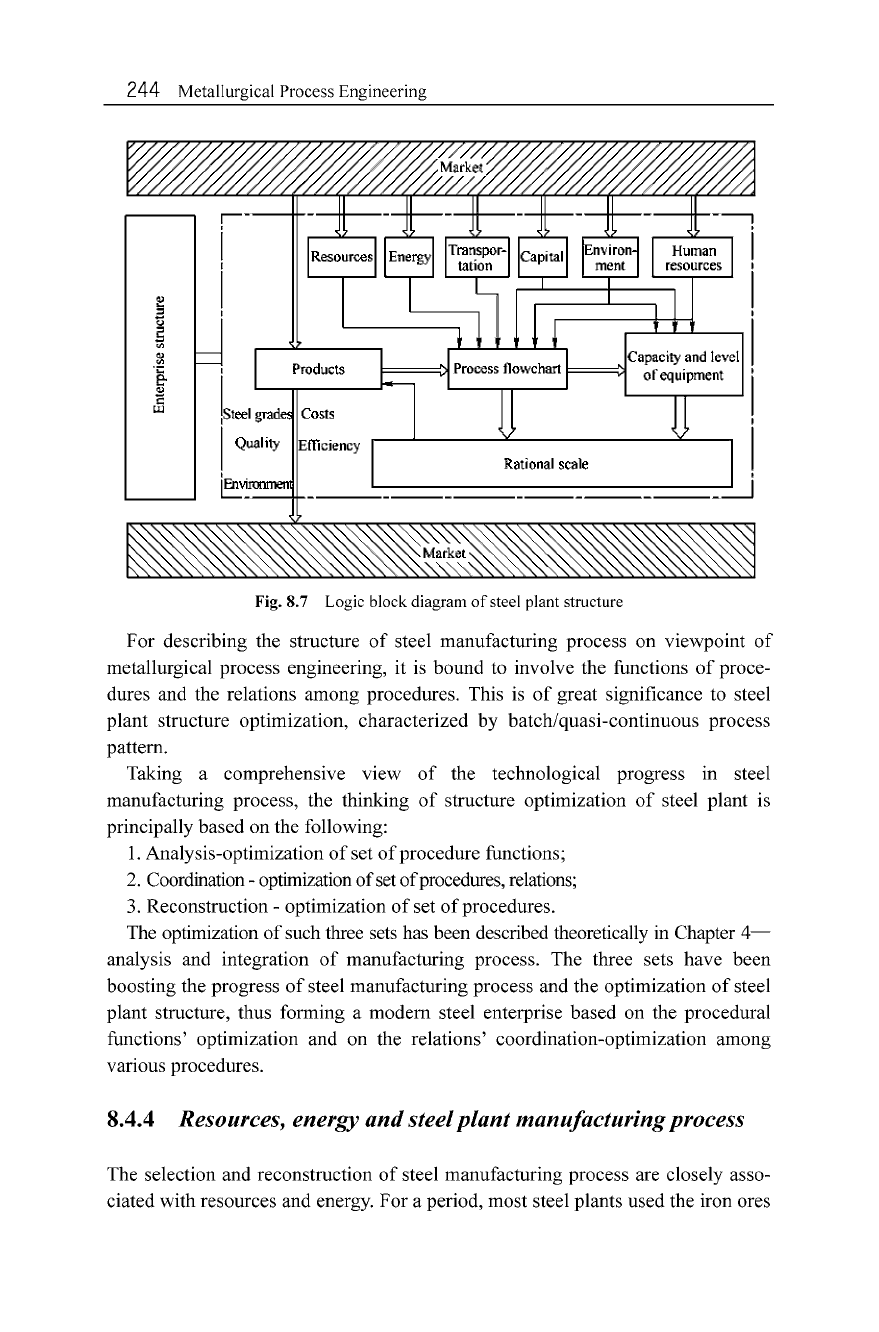
244 Metallurgical Process Engineering
I
!Steel
grad
IQuality
~~
Fig. 8.7 Logic block diagram
of
steel plant structure
For describing the structure
of
steel manufacturing process on viewpoint
of
metallurgical process engineering, it is bound to involve the functions
of
proce-
dures and the relations among procedures. This is
of
great significance to steel
plant structure optimization, characterized by batch/quasi-continuous process
pattern.
Taking a comprehensive view
of
the technological progress in steel
manufacturing process, the thinking
of
structure optimization
of
steel plant is
principally based on the following:
1. Analysis-optimization
of
set
of
procedure functions;
2. Coordination - optimization ofsetof procedures,
relations;
3. Reconstruction - optimization
of
set
of
procedures.
The optimizationof such three sets has been describedtheoretically in Chapter
4-
analysis and integration
of
manufacturing process. The three sets have been
boosting the progress
of
steel manufacturing process and the optimization
of
steel
plant structure, thus forming a modem steel enterprise based on the procedural
functions' optimization and on the relations' coordination-optimization among
various procedures.
8.4.4 Resources, energy
and
steelplant manufacturingprocess
The selection and reconstruction
of
steel manufacturing process are closely asso-
ciated with resources and energy. For a period, most steel plants used the iron ores
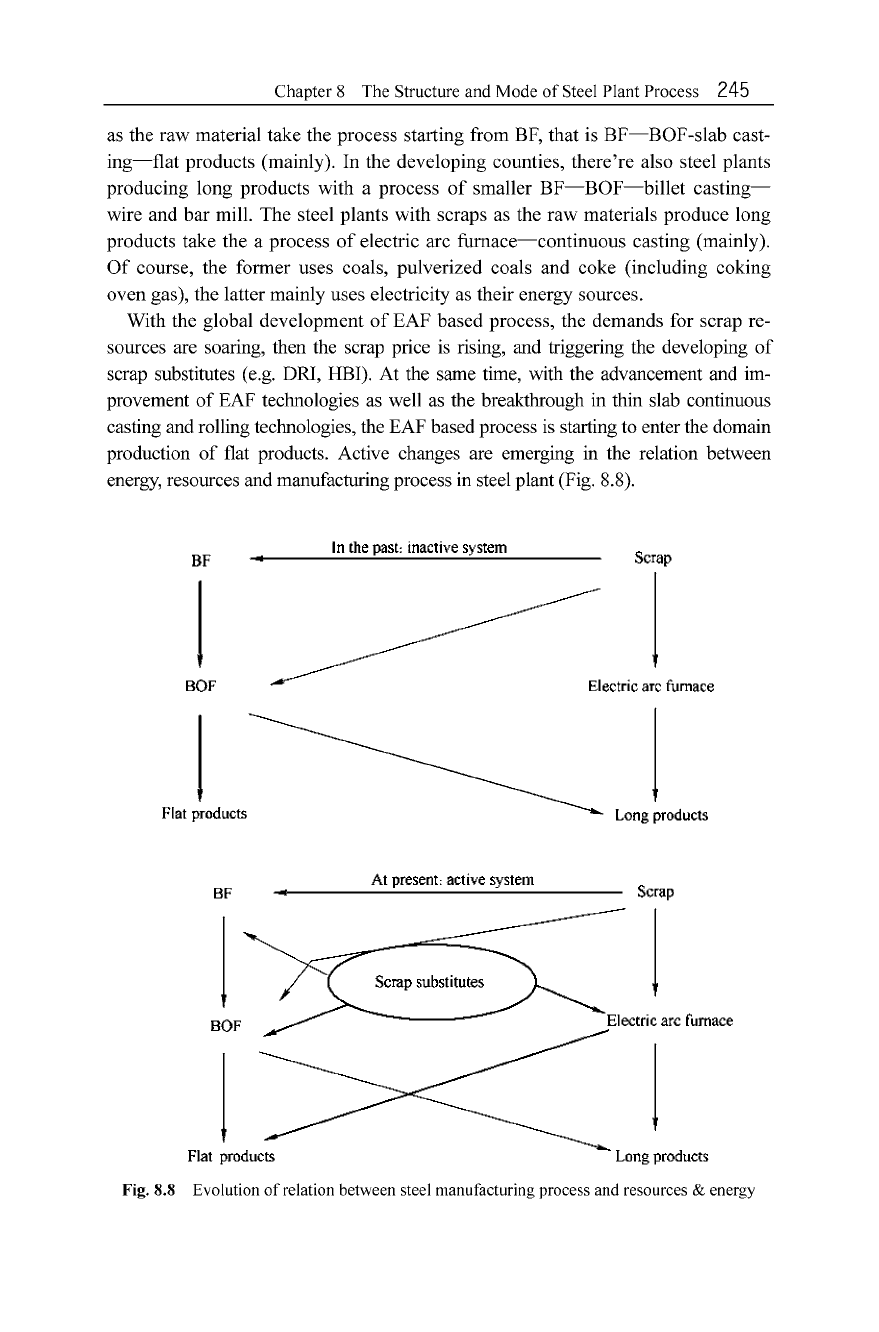
Chapter 8 The Structure and Mode
of
Steel Plant Process 245
as the raw material take the process starting from BF, that is
BF-BOF-slab
cast-
ing
-flat
products (mainly). In the developing counties, there're also steel plants
producing long products with a process
of
smaller BF
-BOF
-billet
casting-
wire and bar mill. The steel plants with scraps as the raw materials produce long
products take the a process
of
electric arc furnace-continuous casting (mainly).
Of
course, the former uses coals, pulverized coals and coke (including coking
oven gas), the latter mainly uses electricity as their energy sources.
With the global development
of
EAF based process, the demands for scrap re-
sources are soaring, then the scrap price is rising, and triggering the developing
of
scrap substitutes (e.g. DRI, HB\). At the same time, with the advancement and im-
provement
of
EAF technologies as well as the breakthrough in thin slab continuous
castingand rolling technologies,the EAF basedprocess is startingto enter the domain
production of flat products. Active changes are emerging in the relation between
energy, resources and manufacturingprocess in steelplant (Fig. 8.8).
BF
j
BOF
In the
past,
inactive
system
Scrap
Electric
arc
furnace
Flat
products
BF
BOF
j
At
present:
active
system
Long
products
Scrap
j
Electric
arc
furnace
j
Flat
products
Long
products
Fig.8.8 Evolution of relationbetweensteel manufacturing processand resources& energy
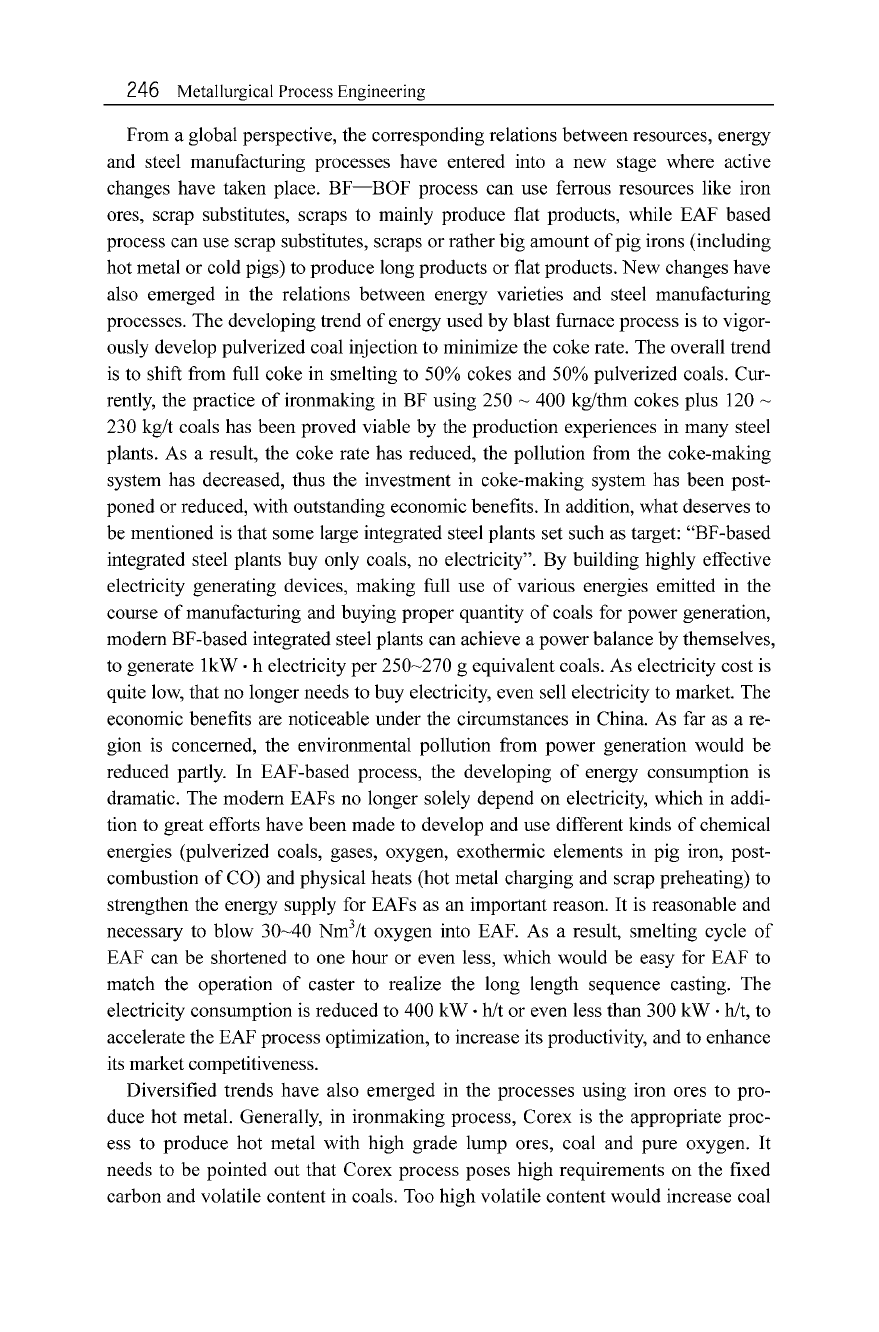
246 Metallurgical Process Engineering
From a global perspective, the corresponding relations between resources, energy
and steel manufacturing processes have entered into a new stage where active
changes have taken place. BF
-BOF
process can use ferrous resources like iron
ores, scrap substitutes, scraps to mainly produce flat products, while EAF based
process can use scrap substitutes, scraps or rather big amount
of
pig irons (including
hot metal or cold pigs) to produce long products or flat products. New changes have
also emerged in the relations between energy varieties and steel manufacturing
processes. The developing trend
of
energy used by blast furnace process is to vigor-
ously develop pulverized coal injection to minimize the coke rate. The overall trend
is to shift from full coke in smelting to 50% cokes and 50% pulverized coals. Cur-
rently, the practice
of
ironmaking in SF using 250
~
400 kg/thm cokes plus 120
~
230 kglt coals has been proved viable by the production experiences in many steel
plants. As a result, the coke rate has reduced, the pollution from the coke-making
system has decreased, thus the investment in coke-making system has been post-
poned or reduced, with outstanding economic benefits. In addition, what deserves to
be mentioned is that some large integrated steel plants set such as target: "SF-based
integrated steel plants buy only coals, no electricity".
By building highly effective
electricity generating devices, making full use
of
various energies emitted in the
course
of
manufacturing and buying proper quantity
of
coals for power generation,
modern SF-based integrated steel plants can achieve a power balance by themselves,
to generate 1kW . h electricity per
250
~270
g equivalent coals. As electricity cost is
quite low, that no longer needs to buy electricity,even sell electricity to market. The
economic benefits are noticeable under the circumstances in China. As far as a re-
gion is concerned, the environmental pollution from power generation would be
reduced partly. In EAF-based process, the developing
of
energy consumption is
dramatic. The modern EAFs no longer solely depend on electricity, which in addi-
tion to great efforts have been made to develop and use different kinds
of
chemical
energies (pulverized coals, gases, oxygen, exothermic elements in pig iron, post-
combustion
of
CO) and physical heats (hot metal charging and scrap preheating) to
strengthen the energy supply for EAFs as an important reason.
It
is reasonable and
necessary to blow
30
~40
Nm
3
It oxygen into EAF. As a result, smelting cycle
of
EAF can be shortened to one hour or even less, which would be easy for EAF to
match the operation
of
caster to realize the long length sequence casting. The
electricity consumption is reduced to 400 kW •
hit or even less than 300 kW . hit, to
accelerate the EAF process optimization, to increase its productivity, and to enhance
its market competitiveness.
Diversified trends have also emerged in the processes using iron ores to pro-
duce hot metal. Generally, in ironmaking process, Corex is the appropriate proc-
ess to produce hot metal with high grade lump ores, coal and pure oxygen.
It
needs to be pointed out that Corex process poses high requirements on the fixed
carbon and volatile content in coals. Too high volatile content would increase coal

Chapter 8 The Structure and Mode
of
Steel Plant Process
247
consumption per tonne
of
iron; too low volatile content would make it hard for the
Corex process to run smoothly. On the contrary, SF can produce hot metal using
lump ores, ore fines, cokes, pulverized coals and blast. Smelting reduction with melt
bath is a suitable process to produce hot metal using large amount
of
ore fines, coals
and pure oxygen (or oxygen enrichment). But generally speaking, in the foreseeable
future, BF would remain the main equipment for producing hot metal. And solid
reduced iron, produced by various direct reduction process, should be used as one
kind of ferrous burden for EAFs or BOFs, as it differs with hot metal.
From the above, it is obvious that international steel industry has entered an ac-
tive stage while burden structure, the energy structure and steel plant process
structure are diversified.
For better market competitiveness, steel plants are facing with tasks ofreorgan-
izing their manufacturing processes. They should select the right product varieties
in accordance with the market demands and their own changes. They should se-
lect corresponding manufacturing process by taking overall consideration
of
re-
sources, energy, products and their transporting conditions, by analyzing price
variation trend
of
resources, energy, products and by paying full attentions to en-
vironmental protection. And they should make assessment and decisions in com-
bination with financial cost and manufacturing cost in the course
of
investment,
construction and production.
8.5 Steel
Plant
Structure Optimization and
Engineering
Design
Engineering design
of
steel plant structure is the fundamental step to practice the
manufacturing process
of
steel production. During the projection
of
new plant and
the reforming-reconstruction
of
current plant it should think about the advanced
technologies in steel manufacture and their rational coordination at all points.
8.5.1 The importance
of
process engineering design
Design is intended to form a system that can operate in an effective and rational
way through correcr, orderly and coordinated combinations. A key concept
of
system science is that a system has two natures:
The first nature refers to the entire nature
of
a system that can be deduced from
the natures
of
its elements(parts). For instance, the weight
of
a vehicle or a plane
is determined by the weights
of
various parts and components.
The second nature is a nature only
of
the system (entirety), not
of
its individual
elements. For instance, a vehicle can carry passengers or goods, a plane can take
off, fly and land safely, and none
of
its parts has such nature.
It
is worthy
of
emphasis that the second nature is just produced by the interac-
